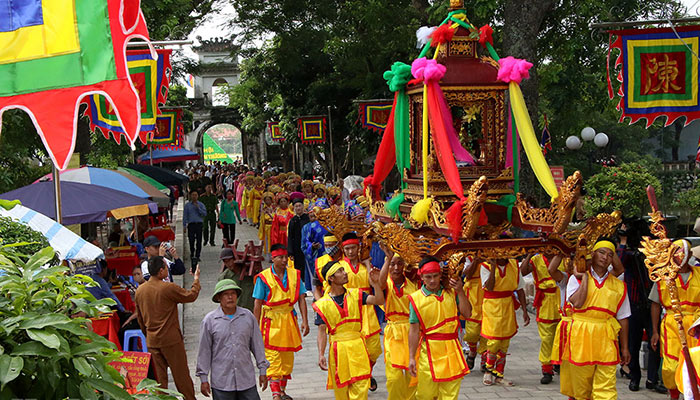3 most famous and oldest festivals in Ha Nam
In the land of Ha Nam, many festivals have become long-standing and characteristic cultural symbols of this locality. Over the centuries, these festivals have not only been a place for people to show respect to their ancestors but also an opportunity to connect the community, preserve and promote traditional cultural values. The most famous and oldest in Ha Nam are the three festivals of Lanh Giang temple, Lieu Doi wrestling festival and Tran Thuong temple festival that have attracted the attention of tourists from all over. Let's learn about these three festivals to better understand the diversity and richness of folk culture in this land.

First, the Lanh Giang temple festival carries long-standing historical and cultural values and the outstanding beauty of artistic architecture. In 1996, the Ministry of Culture and Information classified Lanh Giang temple as a level relic. Nationally, the festival is held twice a year. The festival usually takes place in June or August because this is the time when the Red River threatens with floods and crop failures. The ceremony aims to honour the Three Great Kings and pray to the water god to help people avoid the risk of floods and crop failures. Since 2007, the festival combines tradition and modernity, aiming to preserve cultural values and organise folk games. The festival is held in two parts; The ceremony includes: the announcement ceremony, the procession of water from the Red River into the temple according to the custom of worshipping the water god, the palanquin procession and the opening of the festival; The festival includes: folk games such as duck catching, stick fighting, monkey bridge, etc. The performance of traditional rituals is assigned to the elders in the community to ensure the festival takes place. true to traditional and solemn rituals. Up to now, Lanh Giang Temple is the centre for practising the Chau Van Ritual belief of Ha Nam province, with attention and training from the government and cultural researchers. The festival is a cultural symbol of the Vietnamese people, full of historical and mythological values, and meets the spiritual and cultural needs of the community each year.

Second, the Lieu Doi Wrestling Festival is a cultural symbol of Ha Nam province. Every year, on the 5th day of the first lunar month, in Lieu Doi village, Liem Tuc commune, Thanh Liem district, Ha Nam province, a wrestling festival takes place to commemorate the merits of a brave young man in the Doan family, who had great contribution in defeating the enemy and protecting the country. The community participating in the festival includes villagers of Lieu Doi and other villages with traditions in martial arts. Women are also allowed to participate and demonstrate their wrestling skills no less than men. The process of organising the ceremony begins with the Ceremony of carrying the Saint into the dong (dong is the place where the object is held), meaning the palanquin of the Saint is carried from the temple to the place where the object is held. The offerings to the saints are vegetarian offerings such as a few oan products, a few banana peels, and a cup of tea. An old man holding a sword in his hand leads the procession and after the Holy palanquin closes, the sacrifice is conducted. Next is the Fire Ceremony to commemorate the magical fire emitted from the sword, followed by the Sword Giving and Peach Scarf Ceremony to remember the boy named Doan receiving the magic sword and peach scarf. After the above rituals, the Gathering of Meanings Flag Dancing Ceremony, also known as "Thien Nhan Ky Formation", is performed by two or four participants, each holding a square red flag, advancing from both sides of the holy palanquin. Come out in the middle and dance to the sound of drums. Next is the Thanh Dong Ceremony, starting with the sound of the big drum and other sounds from the wrestling area and temples in the area, responding to enthusiastic cheers. Finally, after the above rituals, the wrestling match begins. Wrestlers can only wear loincloths and be shirtless in the gym. Traditional martial arts wrestling competitions such as armpits, ribs, gong pieces, and beef pieces bring thrill to the audience. Unethical actions such as hooking the jaw and squeezing the genitals are prohibited and severely punished if violated. Lieu Doi wrestling festival demonstrates the martial spirit and solidarity of the Vietnamese people, contributing to enriching the national culture.

Finally, Tran Thuong is a prosperous land, located at the intersection of "Luc Dau Khe" and has the characteristic of "Dolls worshipping Generals", creating favourable conditions for water transportation. During the second war against the Mongol-Yuan army in 1285, Tran Hung Dao chose this area as a place to store food and weapons for the army. His resounding victory made Tran Thuong the place he returned to develop the economy and exempt people from taxes. After his death, local people built a temple to honour him as Saint Tran. Every year, from the 18th to the 20th of the 8th lunar month, the Temple Management Board organises a festival to pay tribute to the merits of Saint Tran and recognize the spirit of honouring origins. This festival also meets the spiritual and cultural needs of the community and tourists. Tran Thuong Temple Festival includes ceremonies and festivals. The ceremony includes rituals such as palanquin procession, incense offering and "Thanh Dong performance" ceremony to honour Saint Tran and pray for good crop weather. The festival has many traditional games and cultural activities, including a chess competition to recreate Tran Hung Dao's strategic talent. In addition to the annual festival, at the hour of the Rat on January 15, the Temple Management Board also organises a Salary Distribution Ceremony to bring fortune to people and tourists, while celebrating and spreading the nation's historical traditions.
Overall, the three traditional festivals in Ha Nam are not only symbols of local culture but also bright spots in the country's cultural heritage. Understanding the profound value and diversity of rituals and traditions here, we realise the preciousness of Vietnam's cultural diversity. Therefore, preserving and developing these festivals is not only the responsibility of local people but also of the entire community and society. By honouring and preserving these characteristics, we are also contributing to enriching the nation's national cultural heritage.

.jpg)








